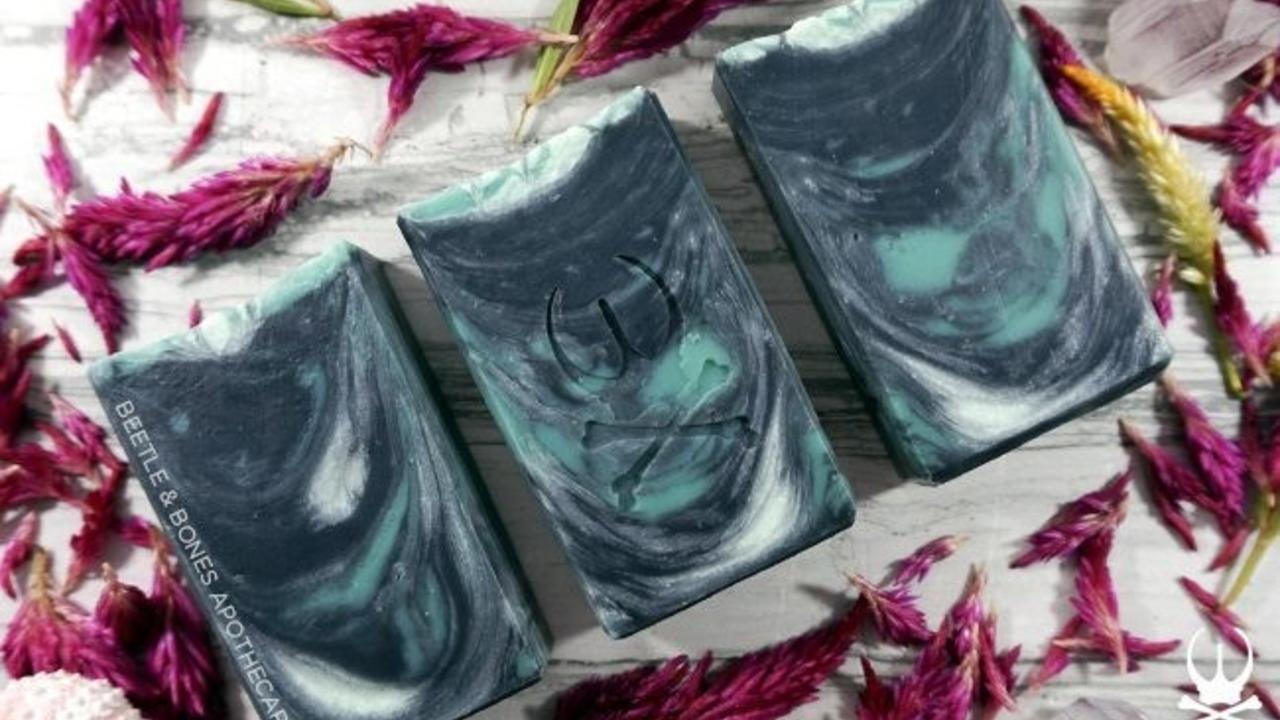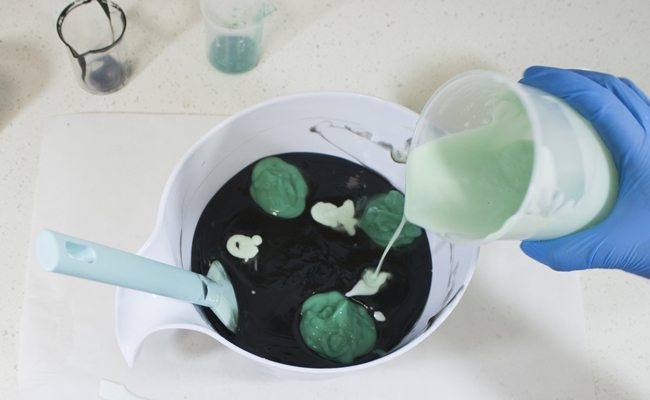Tutorial: Activated Charcoal and Tea Tree Soap Recipe

This tutorial comes to you courtesy of Izza.
You can’t reinvent the wheel but you can definitely take a new spin on it. I love a classic activated charcoal and tea tree soap recipe myself! Instead of doing an all black bar or monotone bar of soap, I wanted to design a soap that paid homage to the tea tree plant with it’s vibrant green and lovely buds. Let's dive in!
 Tutorial: Activated Charcoal and Tea Tree Soap Recipe
Tutorial: Activated Charcoal and Tea Tree Soap Recipe
This soap is sized for a 2.5 Pound Tall and Skinny Mini Basic Mold. You can resize it using a lye calculator for whichever mold works for you. As requested, the formula includes percentages for your convenience.
Soap Recipe Used
- 2.5 oz Apricot Kernel Oil (8.2% of the oils)
- 2 oz Castor Oil (6.6% of the oils)
- 8 oz Coconut Oil (26.2% of the oils)
- 9 oz Olive Oil (29.5% of the oils)
- 8 oz Palm Oil (26.2% of the oils)
- 1 oz Sunflower Seed Oil (3.3% of the oils)
- 4.3 oz Sodium Hydroxide (5% superfat)
- 10.07 oz Liquid (I use 7.07oz Distilled water and 3 oz Coconut milk, which makes a 30% lye solution total)
All soapmaking oils were purchased from Soaper’s Choice (Columbus Foods).
Fragrance Oil Used
- 1.5 oz of Tea Tree Essential Oil
This essential oil is from Bramble Berry, but feel free to use any fragrances or essential oils that your heart desires.
Looking for essential oil blends to use instead? Check out the Essential Oil Blending Calculator!
Colorants Used
- 1.5 tsp Activated Charcoal
- 1.5 tsp Hydrated Chrome Green
- 0.5 tsp Titanium Dioxide (Oil Dispersible)
All colorants were purchased from Bramble Berry, but feel free to use any colorants you like!
Additional Ingredients Used
- 2 tsp Kaolin Clay (Bramble Berry)
- 2 tsp Sodium Lactate (Bramble Berry)
PREP WORK: Slowly and carefully add the lye to the water and gently stir until the lye has completely dissolved and your solution is clear. Weigh out your soaping oils and set aside. I like to do these steps first to allow time for my lye solution and oils to cool down.
(Soaping at a cooler temperatures will allow you more room to play with swirling techniques. I recommend soaping around room temperature - 100° F. Read up here for more information on controlling trace in cold process soapmaking!)
Once your lye solution has cooled, add 2 teaspoons of Sodium Lactate and stir to dissolve. Sodium Lactate is a liquid solution that helps produce a harder bar of cold process soap and aids in the unmolding process. It should be used at a usage rate of 1 teaspoon per pound of oils.
To premix your colorants, use 1 tablespoon of a light liquid oil like sweet almond oil or apricot kernel oil per 1 teaspoon of mica. (Or use 1 tablespoon of oils from your soapmaking oils, if you prefer not to add additional oil to your recipe!) For this recipe, mix the activated charcoal with 1.5 tablespoon of oil, 1 teaspoon of Hydrated Chrome Green with 1 tablespoon of oil and finally, combine 1/2 tsp Hydrated Chrome Green and 1/2 teaspoon of Titanium Dioxide with 1 Tablespoon of oil.
Measure out your fragrance. I like to incorporate the kaolin clay with my Fragrance oil to help anchor the scent and to add slip to my soaps.
 Slowly add your lye solution into your oils to avoid air bubbles, by using your stickblender or a spatula to break the stream while pouring.
Slowly add your lye solution into your oils to avoid air bubbles, by using your stickblender or a spatula to break the stream while pouring.
GET STARTED: Once your oils have cooled, place your stick blender into the oils and burp it to release any air bubbles. Slowly add your lye solution to your oils and stick blend until emulsified. Once emulsified, I like to add the coconut milk into batter and pulse to just combined.
POUR IT / SWIRL IT: Divide a portion of your batter into two additional containers while reserving a larger portion in the main bowl. The large portion will be colored using the activated charcoal, while the other two will be colored green and light green respectively. Once your containers have reached a uniform color, hand stir in the fragrance oil.
 By hand stirring your colorants and fragrance oil our raw batter will remain more fluid allowing you time to play with your soap instead of thickening up too quickly.
By hand stirring your colorants and fragrance oil our raw batter will remain more fluid allowing you time to play with your soap instead of thickening up too quickly.

Pour the light green and green soap into the black activated charcoal soap to create an in-the-pot swirl.
Next, using the black pot as your base soap, we are going to do an in the pot swirl. Using the darker green, pour it in 3 spots around the outside of the bowl, then pour the lighter green in 4 spots in the center.
You can pour the colors randomly into the pot, but I like to have a bit more control. If you want to mimic the swirl I did on the top of the soap batch, reserve a tiny bit of each color for the end. Swirl the colors separately in the pot and pour it into the mold.
 Lightly swirl the colored soap into the black soap to create this activated charcoal and tea tree soap with an in the pot swirl!
Lightly swirl the colored soap into the black soap to create this activated charcoal and tea tree soap with an in the pot swirl!
FINISHING UP: After tapping down your mold to release any trapped air bubbles, scrape out any of the remaining batter into your mold. Using the remainder of the light green batter, dot it down the center of the mold, then add the darker green randomly on top, followed by the black. Taking a skewer, swirl the colors together without over mixing.
 Swirling up the top of the activated charcoal and tea tree soap recipe in the mold!
Swirling up the top of the activated charcoal and tea tree soap recipe in the mold!
Spritz the top of your activated charcoal and tea tree soap with isopropyl alcohol to help avoid soda ash and insulate for 24 hours. Carefully remove from the mold and cut into bars, allowing the soap to cure for 4-6 weeks.
 Cut and cured activated charcoal and tea tree soap recipe!
Cut and cured activated charcoal and tea tree soap recipe!
Want to see this soap being made before you try it yourself?
This activated charcoal and tea tree soap recipe featured in this tutorial is a vegan-friendly formula. Unlike many other Modern Soapmaking tutorials, this soap recipe is not a palm-free formula. It used a 5% superfat and a 30% lye solution. Feel free to adjust as necessary!
Want to snag weekly advice on building a successful soap biz directly in your inbox?
Of course you do! Sign up for our newsletter below for more tips and tricks to make bank in your biz.

